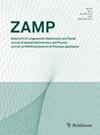年龄空间结构疟疾流行模型的动力学分析
IF 1.6
3区 数学
Q2 MATHEMATICS, APPLIED
Zeitschrift fur Angewandte Mathematik und Physik
Pub Date : 2023-10-06
DOI:10.1007/s00033-023-02097-4
引用次数: 0
摘要
在本文中,我们将重新审视Lou和Zhao (J Math Biol 62:543-568, 2011)所研究的模型,该模型采用由固定潜伏期引起的非局部延时反应扩散模型的形式。我们认为感染年龄是一个连续变量,但不受固定潜伏期的限制,从而在有界域中得到年龄空间结构的疟疾模型。通过初步分析,通过证明解的整体存在性,研究了模型的适定性,定义了所有参数保持不变时基本再现数的显式公式。通过分析特征方程和设计合适的Lyapunov函数,建立了常无病平衡点和正平衡点的阈值动力学。我们的理论结果也通过一维和二维的数值模拟得到了验证。本文章由计算机程序翻译,如有差异,请以英文原文为准。

Dynamical analysis of an age-space structured malaria epidemic model
Abstract In this paper, we will revisit the model studied in Lou and Zhao (J Math Biol 62:543–568, 2011), where the model takes the form of a nonlocal and time-delayed reaction–diffusion model arising from the fixed incubation period. We consider the infection age to be a continuous variable but without the limitation of the fixed incubation period, leading to an age-space structured malaria model in a bounded domain. By performing the elementary analysis, we investigate the well-posedness of the model by proving the global existence of the solution, define the explicit formula of basic reproduction number when all parameters remain constant. By analyzing the characteristic equations and designing suitable Lyapunov functions, we also establish the threshold dynamics of the constant disease-free and positive equilibria. Our theoretical results are also validated by numerical simulations for 1-dimensional and 2-dimensional domains.
求助全文
通过发布文献求助,成功后即可免费获取论文全文。
去求助
来源期刊
CiteScore
2.90
自引率
10.00%
发文量
216
审稿时长
6-12 weeks
期刊介绍:
The Journal of Applied Mathematics and Physics (ZAMP) publishes papers of high scientific quality in Fluid Mechanics, Mechanics of Solids and Differential Equations/Applied Mathematics. A paper will be considered for publication if at least one of the following conditions is fulfilled:
The paper includes results or discussions which can be considered original and highly interesting.
The paper presents a new method.
The author reviews a problem or a class of problems with such profound insight that further research is encouraged.
The readers of ZAMP will find not only articles in their own special field but also original work in neighbouring domains. This will lead to an exchange of ideas; concepts and methods which have proven to be successful in one field may well be useful to other areas. ZAMP attempts to publish articles reasonably quickly. Longer papers are published in the section "Original Papers", shorter ones may appear under "Brief Reports" where publication is particularly rapid. The journal includes a "Book Review" section and provides information on activities (such as upcoming symposia, meetings or special courses) which are of interest to its readers.

 求助内容:
求助内容: 应助结果提醒方式:
应助结果提醒方式:


